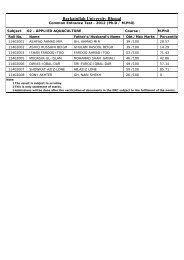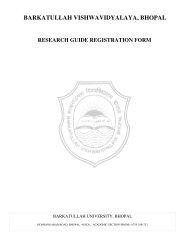cjdrmYyk fo'ofo|ky;] Hkksiky cjdrmYyk fo'ofo|ky - Barkatullah ...
cjdrmYyk fo'ofo|ky;] Hkksiky cjdrmYyk fo'ofo|ky - Barkatullah ...
cjdrmYyk fo'ofo|ky;] Hkksiky cjdrmYyk fo'ofo|ky - Barkatullah ...
You also want an ePaper? Increase the reach of your titles
YUMPU automatically turns print PDFs into web optimized ePapers that Google loves.
Max Min Aggregate100 40 50%Group- CBusiness lawIIILaw of Export Import RegulationBanking lawMax Min Aggregate100 40 50%Group- EEnvironmental law and Legal OrderIIIPreventation and control of pollutionEnvironment and international legal orderMax Min Aggregate100 40 50%Group -GConstitution and Legal OrderIIIUnion-state financial relationsConstitutionalism: pluralism and federalism4
LL.M. Part – I – Semester- IIMax. Mark: 100 Min. Marks: 40JUDICIAL PROCESSObjective of the courseA lawyer, whether academic or professional, is expected to be competent toanalyze and evaluate the legal process from a broader justice perspective. Hence acompulsory paper on judicial process is essential in the LL.M. curriculum. Theobjective of this paper is to study the nature of judicial process as an instrument ofsocial ordering. It is intended to highlight the role of court as policy maker,participant in the power process and as an instrument of social change. This paperfurther intends to expose the intricacies of judicial creativity and the judicial toolsand techniques employed in the process.Since the ultimate aim of any legal process or system is pursuit of justice, asystematic study of the concept of justice and its various theoretical foundations isrequired. This paper, therefore, intends to familiarize the students with varioustheories, different aspects and alternative ways, of attaining justice.Syllabus1. Nature of judicial process1. Judicial process as an instrument of social ordering2. Judicial process and creativity in law – common law model – LegalReasoning and growth of law – change and stability3. The tools and techniques of judicial creativity and precedent4. Legal development and creativity through legal reasoning under statutoryand codified systems2. Special dimensions of Judicial Process in Constitutional Adjudications1. Nations of judicial review2. Role in constitutional adjunctions – various theories of judicial role3. Tools and techniques in policy– making and creativity in constitutionaladjunction4. Varieties of judicial and justice activism5. Problems of accountability and judicial law making3. Judicial Process in India1. Indian debate on the role of judges and on the nation of judicial review6
2. The “Independence” of judiciary and the “Political” nature of judicialprocess3. Judicial activism and creativity of the Supreme Court – the tools andtechniques of creativity4. Judicial process in pursuit of constitutional goals and values – newdimensions of judicial activism and structural challenges5. Institutional liability of courts and judicial activism-scope and limits4. The concepts of Justice1. The concept of justice or Dharma in Indian thought2. Dharma as the foundation of legal ordering in Indian thought3. The concept and various theories of justice in the western thought4. Various theoretical bases of justice: the liberal contractual tradition, theliberal utilitarian tradition and the liberal moral tradition5. Relation between Law and Justice1. Equivalence Theories – Justice as nothing as nothing more than thepositive law of the stronger class2. Dependency theories – for its realization justice depends on law, butjustice is not the same as law3. The independence of justice theories-means to end relationship of law andjustice- the relationship in the context of the Indian constitutional ordering4. Analysis of selected cases of the Supreme Court where the judicial processcan be seen as influenced by theories of justiceSelected bibliography1. Julus Store, The Province and Function of Law, Part II Chs. 1. 8-16(2000), University New Delhi2. Carzo, The Nature of Judicial Process (1995) Universal, New Delhi3. Henry J. Abraham, The judicial Process (1998), Oxford4. J. Stone, Precedent and the Law: Dynamics of Common Law Growth(1985) Butterworths5. W.Friedmann, Legal Theory(1960), Stevens, Landon6. Bodenheimer, Jurisprudence-the Philosophy and Method of the Law(1997), Universal, Delhi7. J. Stone, Legal System and Lawyers’ Reasoning (1999), Universal Delhi8. U. Baxi, The Indian Supreme Court of India – A Socio – Legal Critique ofits Juristic Techniques (1977), Tripathi, Bombay9. John Rawls, A Theory of Justice (2000), Universal, Delhi10. Edward H. Levi, An Introduction to Legal Reasoning (1970), Universityof Chicago7
LL.M. Part – I – Semester- IIMax. Mark: 100 Min. Marks: 40GROUP – BCRIMINAL LAWPRIVILEGED CLASS DEVIANCEObjective of the CourseThis course focuses on the “Privileged classes”. The definition of “Privilegedclasses” in a society like India should not pose major problem at all the expressionnearly includes weilders of all forms of State and social (including religious)power. Accordingly, the course focuses on the relation between privilege powerand deviant behaviour. The traditional approaches which highlight "white-collaroffences", "socio-economic offences" or "crime of the powerful" deal mainly withthe deviance of the economically resourceful. The dimension of devianceassociated with bureaucracy, the new rich (nouveau riche), religious leaders andorganizations, professional classes and the higher bourgeoisie are not fullycaptured here.In designing teaching materials of this course, current developments in deviance,as reflected in newspapers/ journals, law reports and legislative proceedingsshould be highlighted.It should be stressed that the objectives of the course include:(a)(b)(c)(d)Dispelling of the commonly held belief that deviances crime is usuallyassociated with the impoverished or improvident;Constructions of model so understanding the reality of middle andupper; middle class deviance criminality in India;Critical analyses of legal system responses andIssue and dilemmas in penal and sentencing policies.Syllabus1. IntroductionConceptions of white-collar crimesIndian approaches to socio-economic offences8
Notions of privileged class deviances as providing a wider categorization ofunderstanding Indian developmentTypical forms of such devianceOfficial deviances (deviance by legislators, judges, bureaucrats)Professional deviance: journalists, teachers, doctors, lawyers, engineers,architects and publishersTrade union deviance (including teachers, lawyers/urban property owners)Landlord deviances (class/caste based devinace)Police deviancesDeviance on electoral process (rigging, booth capturing, impersonation,corrupt practices)Gender- based aggression by socially, economically and politically powerfulNote: Depending on specialist interest by the teacher and the taught any threeareas of deviance of privileged class may be explored. What follows is onlyillustrative of one model of doing the course.2. Official Deviance1. Conception of official deviance- permissible limit of discretionary powers2. The Chambal valley dacoit Vinoba Mission and Jai Prakash NarainMission – in 1959 and 19713. The Chagia Commission Report on LIC Mundra Affair4. The Das Commission Report on Pratap Singh Kairon5. The Grover Commission Report on Dev Raj Urs6. The Maruti Commission Report7. The Ibakkar- Natarajan Commission Report on Fairfax3. Police DevianceStructures of legal restraint on police power in IndiaUnconstitutionality of "third-degree" methods and use of fatal force by police"Encounter" killingsPolice atrocitiesThe plea of superior ordersrape and related forms of gender-based aggression by police and para-militaryforcesReforms suggestions especially by the National Police Commissions4. Professional DevianceUnethical practices at the Indian barThe Lentin Commission reportThe Press Council on unprofessional and unethical journalism9
Medical malpractice5. Response of Indian Legal Order to the Deviance of Privileged ClassesVigilance CommissionPublic Accounts CommitteeOmbudsmanCommissions of EnquiryPrevention of Corruption Act, 1947The Antulay CaseSelected bibliography1. Upendra Baxi, The Crisis of the Indian Legal System (1982) VikasPublishing House, New Delhi2. Upendra Baxi, (ed.), Law and Poverty: Essays (1988)3. Upendra Baxi, Liberty and Corruption: The Antulay Case and Beyond(1989)4. Surendra Nath Dwevedi and G.S. Bhargava, Political Corruption in India(1967)5. A.R. Desai (ed.) Violation of democratic Rights in India (1986)6. A.G. Noorani, Minister's Misconduct (1974)7. B.B. Pande, The Nature and Dimensions of Privileged Class Deviance "Inthe othe side of development 136 (1987; K.S. Shukla ed.)8. Indira Rotherm und, "Patterns of Trade Union Leadership in DhanbadCoal Fields"23 J.I.L.I 522 (1981)10
LL.M. Part – I – Semester- IIMax. Mark: 100 Min. Marks: 40GROUP – B CRIMINAL LAWDRUG ADDICTION, CRIMINAL JUSTICE AND HUMAN RIGHTSObjective of the CourseAlmost all the major dilemmas of criminal policy surface rather acutely incombating drug addiction and trafficking through the legal order. The issue ofinteraction between drug abuse and criminality is quite complex. At least threeimportant questions have been recently identified as crucial for comparativeresearch. First to what extent drug dependence contributes to criminal behaviour?Apart from these causal issues, there are the broad questions of the social costsbenefitsof criminalization of addictive behaviour. Should drug taking remain inthe category of of "crime without victism?" or should it be viewed as posting anever- growing threat to human resource development and be subjected to statecontrol, over individual choices as to survival and life- styles?The problems here are not merely ideological or theoretical. User of drugs forpersonal, non-therapeutic purpose may will be linked with internationaltrafficking in psychotropic substances. It has even been suggested thatencouragement of drug- dependency may have, in addition to motivation of highprofiles, politically subversive aspects.Assuming that both addiction and trafficking have to be regulated, what penalpolices should be appropriate? What human rights costs in the administration ofcriminal justice should be considered acceptable? The international response tothese questions is indicated by the Single convention on narcotic drugs, 1961,adopted in New York, 30 March 1961 and as amended by 1972 protocol inGeneva, 25 March, 1972 and the convention on psychotropic substances, adoptedin Vienna, 21 February 1971, India has recently adopted the basic principles ofthese conventions in the narcotic drugs and psychotropic substances Act, 1986Broadly, penal policy dilemmas here relate to: (a) management of sanctionsrelating to production, distribution and illicit commerce in narcotic substancesand, (b) ways of prevention of abuse of drugs, including speedy diagnosis,treatment, correction, aftercare, rehabilitation, and realization of persons affected.Important problems of method in studying in the impact of regulation needevaluated at every stages.11
Nationalist thought towards regulation of drug trafficking and usageThe penal provisions (under the IPC and the customs Act)India’s role in the evolution of the two international conventionsJudicial approaches to sentencing in drug trafficking and abuseThe narcotic drugs and psychotropic substances Act, 1985Patterns of resource investment in India: policing adjudication, treatment,aftercare and rehabilitation6. Human Rights AspectsDeployment of marginalized people as carrier of narcoticsThe problem of juvenile drug and legal approachesPossibilities of misuse and abuse of investigative prosecutor powersBailThe problem of differential application of the Ugal Regimes, especially inrelation to the resource less7. The Role of Community In Combating Drug Addiction1. Profile of community initiatives in inhabitation of dependence andaddiction (e.g. de addiction and aftercare)2. The role of educational systems3. The role of medical profession4. The role of mass media5. Initiative for compliance with regulatory systems6. Law reform initiativesSelected bibliography1. H.S. Becker, outsiders: The Studies in Sociology of Deviance (1966)2. J.A. Incard, C.D. Chambers (eds.), Drug and the Criminal Justice System(1974)3. R. Cocken, Drug abuse and Personality in Young Offenders (1971)4. G. Edwards Busch, (ed.) Drug Problems in Britain: A Review of TenYears (1981)5. P. Kondanram and Y.N. Murthy, "Drug Abuse and Crime: A PreliminaryStudy" 7 Indian Journal of Criminology, 65-68 (1979)6. P.R. Rajgopal Violence and Response: A Critique of the Indian CriminalSystem (1988)7. United Nations, Economics and Social Reports of the Commission onNarcotic Drugs, United Nations8. Social Defence, Research Institute (UNSDRI) combating drug abuse andrelated crimes (Rome, July 1984, publication No. 21.)9. Lok Sabha and Rajya Sabha debates on 1986 bill on psychotropicsubstances. Useful journals in this area are:13
10. The Law and Society Review (USA)11. Journal of Drug Issue (Tallahassee florida)12. International journal of Addictions (New York)13. British journal of Criminology Law, Criminology and police sciences(Baltimore, Md.)14. Journal of Criminal Law and Criminology (Chicago, III)15. International Journal of Offenders Therapy and Comparative Criminology(Landon)16. Bulletin on Narcotics (United Nations)14
LL.M. Part – I – Semester- IIMax. Mark: 100 Min. Marks: 40Group – C:BUSINESS LAWSLAW OF EXPORT IMPORT REGULATIONObjectives of the courseAfter independence India has embarked upon all round efforts to modernize hereconomy through developmental ventures. Greater and greater emphasis is placedon increase of production in both industrial and agricultural sectors. Besides, therewas the ever- pressing need for raising capital for investment of capital. Theprocess of modernization necessitated the adoption of never technologies forindustry and agriculture. These technologies had to be borrowed from otherdeveloped countries. This in turn, needed foreign exchange, which could beearned by the increased exports of goods and raw materials from India.The need for accelerating the export trade of India’s developing economy canhardly be over emphasized. Export earnings enable a developing country tofinance its massive requirements of growth, to maintain its essential imports andthereby stimulate the process of its economic developments. In the words of Prof.V.K. R.V. Rao: "In fact expansion of exports may well be described as an integralpart of the development process, neglect of which can only be at the peril ofdevelopment itself.Increasing exports have been necessitated to meet the growing needs of defence.India is a country rich in natural resources. One of the approaches to combat itseconomic backwardness could be in large-scale production and maximization ofits exportsImport that exports of goods and raw materials is a complex, complicated andintricate activity. It involves elaborate economic, fiscal, budgetary and monetarypolicy considerations. Export and import control policy is also closely connectedwith country’s balance of payment positionThe detailed procedures for imports and exports are provided in the Hand Book.The Union government used to declare its import and export policy for a threeyearperiod. At present they declare that policy for five years. The controls onexports and imports are closely connected with the Foreign Trade Regulation Act1992Syllabus1. Introduction15
State control over import and export of goods- from rigidity toliberalizationImpact of regulation on economy2. The Basic Needs of Export and Import TradeGoodsServicesTransportation3. International RegimeWTO arrangementWTO and tariff restrictionsWTO and non- tariff restrictionsInvestment and transfer of technologyQuota restriction and anti-dumpingPermissible regulationsQuarantine regulationDumping of discarded technology and goods in international marketReduction of subsidies and counter measures4. General Law on Control of Imports and exportsGeneral schemeLegislative controlPower of control: Central government and RBIForeign Trade Development and Regulation Act 1992Restrictions under customs lawProhibition and penaltiesExport-Import formulation: guiding featuresControl under FEMAForeign exchange and currencyImport of goodsExport promotion councilsExport oriented units and export processing zones5. Control of Exports1. Quality control2. Regulation on goods3. Conversation of foreign exchange4. Foreign exchange management5. Currency transfer6. Investment in foreign countries16
6. Exim policy: Changing DimensionsInvestment policy: NRIs, FIIs(foreign institutional investors), FDIsJoint venturePromotion of foreign tradeAgricultural productsTextile and clothsJewelleryService sector7. Law Relating to CustomsProhibition on importation and exportation of goodsControl of smuggling activities in export-import tradeLevy of and exemption from, customs dutiesClearances of imported goods and export goodsConveyance and warehousing of goods8. Regulation on InvestmentBorrowing and lending of money and foreign currencySecurities abroad-issue ofImmovable property-purchase abroadEstablishment of business outsideIssue of derivatives and foreign securities – GDR(global depositoriesreceipts), ADR (American depository receipts) and UroInvestment in Indian banksRepatriation and surrender of foreign securities9. Technology transferRestrictive terms in technology transfer arrangementsAutomatic approval schemesSelected bibliography1. Government of India, Handbook of Import exports Procedures, (refer tothe latest edition)2. Government of India Import and Export Policy (1997-2002)3. The students should consult the relevant volumes of the Annual Survey ofIndian Law, Published by the Indian law Institute, New Delhi4. Foreign Trade Development and Regulation Act 1992 and Rules5. Foreign Exchange Management Act 19996. Marine Products Export Development Authority Act 19727. Customs Manual (Latest edition)8. Final, Treaty of GATT, 199417
LL.M. Part – I – Semester- IIMax. Mark: 100 Min. Marks: 40GROUP CBUSINESS LAWBANKING LAWObjective of the CourseA vitally important economic institution the banking system is deeply influencedby socio-political and economic changes. The emerging changes in India,particularly after the initiation of the planning process as an instrument of rapideconomic development had moulded and affected the banking structure, policies,patterns and practices. A significant development in the banking system isdiversification in banks financing. The commercial banks entered into the field ofwide ranging financial assistance to industry, both large and small scale, requiringthe need for social control of the banking system eventually leading to thenationalization of banks.The conventional banking system, found to be deficient for planneddevelopmental purposes paved the way for developmental banking. The fag endof the last millennium witness influx of foreign banking companles into India anda shift in the banking policy as part of the global phenomenon of liberalization.The legal system is adopting itself into the new mores.This course is designed to acquaint the students with the conceptual andoperational parameters of banking law, the judicial interpretation and the new andemerging dimensions of the banking systemSyllabus1. Introduction1. Nature and development of banking2. History of banking in India and elsewhere-indigenous banking-evolutionof banking in India- different kinds of banks and their functions3. Multi-functional banks-growth and legal issues2. Law Relating to Banking Companies in India1. Controls by government and its agencies2. On management3. On accounts and audit4. Lending18
5. Credit policy6. Reconstruction and reorganization7. Suspension and winding up8. Contract between banker and customer: their rights and duties3. Social Control over BankingNationalizationEvaluation: private ownership, nationalization and disinvestmentsProtection of depositorsPriority lendingPromotion of under privileged classes4. Deposit Insurance1. The deposit Insurance Corporation Act 1961: objects and reasons2. Establishment of capital of DIC3. Registration of banking companies insured banks, liability of DIC todepositors4. Relations between insured banks, DIC and Reserve Bank of India5. The Central Bank1. Evolution of Central Bank2. Characteristics and functions3. Economic and social objectives4. The Central Bank and the State – as bankers bank5. The Reserve Bank of India as the Central Bank6. Organizational structure7. Functions of the RBI8. Regulation of monitory mechanism of the economy9. Credit control10. Exchange Control11. Monopoly of currency issue12. Bank rate policy formulation13. Control of RBI over non-banking companies14. Financial companies15. Non-financial companies6. Relationship of Bankers and CustomerLegal characterControl between banker and customerBanker’s lienProtection of bankersCustomers19
Nature and type of accountsSpecial classes of customers- lunatics, minor, partnership, corporations, localauthoritiesBanking duty to customersConsumer protection: banking as service7. Negotiable InstrumentsMeaning and kindsTransfer and negotiationsHolder and holder in due coursePresentment and paymentLiabilities of parties8. Lending by BankingGood lending to poor massesSecurities for advancesKinds and their merits and demeritsRepayment of loans: rate of interest protection against penaltyDefault and recoveryDebt recovery tribunal9. Recent Trends of Banking System in IndiaNew technologyInformation technologyAutomation and legal aspectsAutomatic teller machine and use of InternetSmart cardUse of expert systemCredit cards10. Reforms in Indian Banking LawRecommendations of committees: a reviewSelected bibliography1. Basu, A Review of Current Banking Theory and Practise (1998) MacMillan2. M. Hapgood (ed.), Pagets’ Law of Banking (1989) Butterworths, London3. R. Goode, Commercial Law, (1995) Penguin, London4. Rose Cranston, principles of Banking Law (1947) Oxford5. L.C. Goyle, The Law of Banking and Bankers (1995) Eastern20
6. M.L. Tannan, Tannan’s Banking Law and Practice in India (1997) IndiaLaw House, New Delhi, 2 Volumes7. K.C. Shekhar, Banking Theory and Practice (1998) USB PublisherDistributors Ltd. New Delhi8. M. Dassesses, S. Isaacs and G. Pen, E.C. Banking Law, (1994) Lioyds ofLandon Press, Landon9. V. Conti and Hamaul (eds.), Financial Makers’ Liberalization and theRole of Banks’ Cambridge University Press, Cambridge, (1993)10. J. Dermine (ed.), European Banking in the 1990s’ (1993) Blackewll,Oxford11. C. Goodhart, The Central Bank and the Financial System (1995),Macmillan, Landon12. S. Champon, The Rise of Merchant Banking (1984) Allen Unwin, Landon13. K. Subrahmanyan, Banking Reforms an India (1997) Tata Maigraw Hill,New Delhi14. Subodh Markandeya and Chitra Markendeya, Law Relating to Foreigntrade in India: Being a Commentry on the Foreign Trade, (Developmentand Regulation) Act 1992, Universal Law Publishing Co. Pvt. Ltd. Delhi15. R.S. Narayana, The Recovery of Debts due to Banks and FinancialInstitutes Act, 1993 (51 of 1993), Asia Law House, Hyderabad16. M.A. Mir, The Relating to Bank Gurantee in India (1992), MetropolitanBook, New Delhi17. Anthony Pierce, Demand Gurantee in International Trade (1993), Sweetand Maxwell18. Ross Cranston (ed.) European Banking Law: The Bankers-CustomerRelationship (1999) LlP, Landon19. Mitra, The Law Relating to Bankers’ Letters of Credit and Allied Laws,(1998) University Book Agency, Allahabad20. R.K. Talwar, Report of Working Group on Customer Service in Banks21. Jankiraman Committee Report on Securities Operation of Banks andFinancial Institution (1993)22. Narasimham Committee Report on the Financial System (1991)-SecondReport (1999)21
LL.M. Part – I – Semester- IIMax. Mark: 100 Min. Marks: 40GROUP EENVIRONMENTAL LAW AND LEGAL ORDERPREVENTATION AND CONTROL OF POLLUTIONObjectives of the CoursePollution hazards bring the worst harm to the environment. Legal measures areattempted to prevent or control various kinds of pollution and their aftermath. Canland pollution hazards be prosonlod or controlled effectively by criminalsanctions especially in a developing country like India? What other legalstrategies can be adopted at this level? To what extent can corporate civil liabilitybe extended for remedying pollution maladies particularly mass disasters? Onehas to be a critic of the existing laws and to look forward to desirable mechanismof control over pollution hazards.Syllabus1. Pollution1. Meaning2. Kinds of pollution and their impact2. Pollution of water1. Definition2. Ground water pollution3. Sources4. Critique of existing5. Machinery6. Powers7. Function8. Offences and penalties3. Pollution of Air1. Pollutants and effects2. Modalities of control3. Conflicts of jurisdiction of different control4. Agencies5. Critique of the existing legal framework4. Noise Pollution22
1. Sources and effects2. Different legal controls3. Ned for specific law5. Disposal of Waste1. Kinds of wastes2. Disposal agencies: local bodies and other agencies3. Disposal and recycling of wastes6. Sanctions against pollution1. Efficacy of criminal and civil sanctions2. Corporate liability, civil and criminal3. Should penalties be prohibitive?4. Civil liability, compensatory and penal5. Administrative compensation system6. Incentives to pollution controlSelect bibliography1. Kailash Thakur, Environmental Protection Law and Policy in India(1997), Deep & Deep Pub. New Delhi2. Enid. M. Barson and llga Neilson (eds.), Agriculture and Sustainable Usein Europe (1998), Kluwer3. John F.M.c. Eldownery and Sharron Mc. Eldownery, Environmental Lawand Regulation (2000), Blackstone Press4. Leelakrishan, P.et. al. (eds.), Law and Environment (1990)5. Frodorick R.Anderson, et.al. Environmental Improvement ThroughEconomic Incentives (1977)6. David huges, Environmental Law (1999), Butterworths, London7. Daniel R. Mandekar, Environmental and Land Controls Registration(1976), Bobbs – Merri, New York8. Indian Law Institute, Mass Disasters and Multinational Liability: TheBhopal Case (1986)23
LL.M. Part – I – Semester- IIMax. Mark: 100 Min. Marks: 40GROUP EENVIRONMENTAL LAW AND LEGAL ORDERENVIRONMENT AND INTERNATIONAL LEGAL ORDERObjectives of the courseThrough the centuries of their growth, Societies had done their best to keep theirneighborhood clean and health. Industrialization brought in its wakeunprecedented and unpredicted environmental hazards and upset the old ethos andequilibrium. The environmental consciousness is an offshoot of this saga ofindustrial growth. It is said that the world environmental consciousness had madea radical change in the character of international law from a moral code of ethicsamong nations to an almost positive law imposing on the states to observeenvironmental norms. Striking a significant note at the close of the lastmillennium, areas of international concern on environment are legion. Modes ofreconciling the conflicts are also varied. The concepts of sustainable developmentis a significant tool both at the international level and at the domestic system forreconciliation of environmental values and development needs.Syllabus1. International Concern for Environment Protection1. World environment movement2. Natural and cultural heritage3. Role of international and regional organizations2. International Obligation towards Sustainable Development1. International financing policy2. World environment fund3. Global environmental Facility (GEF)4. International co-operation5. Poverty alleviation3. Marine Environment1. Marine resources: conservation and exploitation2. Scientific research and exploration3. Antarctic environment4. International Seabed Authority5. Pollution from ships6. Dumping of oil and other wastes into the sea24
4. Trans- boundary Pollution Hazards1. Oil pollution2. Nuclear fallouts and accidents3. Acid rain4. Chemical pollution5. Green house effect6. Depletion of ozone layer7. Space pollution5. Control of Multinational Corporations and Containment ofenvironmental Hazards1. Problems of liability and control mechanisms2. Disasters management at international level3. Monopoly of biotechnology by MNCs6. Disposal and Dumping of Hazardous Wasres: Transnational Problemand ControlSelect bibliography1. Priya Kanjan Trivedi, International Environmental Laws (1996), A.P.H.Pub. Corporation, New Delhi2. Sir Elworthy and Jane Holder, Environmental Protection: Text andMaterials (1997), Butterworths3. Nathali L.T.J. Horbach, Contemporary Development in Nuclear EnergyLaw (1999), Kluwer4. Henrick Ringbom (ed.), Competing Norms in the Law of MarineEnvironmental Protection (1997), Kluwer5. Claus Bosseimann and Benjamin J. Richardson, Enviromental Justice andMarket Mechanism (1999), Kluwer6. Jean- Pierre Beuier, New Technology and Law of Marine Environment(2000), Kluwer7. Richard L. Reversz et.al. (eds.), Environmental Law, the Economy andSustainable Development (2000), Cambridge8. Dovor Vidas, Protecting the Polar Marine Environment (2000),Cambridge9. Aynsely Kellor, International Toxic Risk Management (1999), Cambridge10. British Institute of International and Comparative Law, SelectedDocuments on International Environmental Law (1975), London11. Standing Committee on Environmental Law American Bar Association,Common Boundary Common Prtoblems: The EnvironmentalConsequences of Energy Production (1982)12. J.M. Spector, “Elephants, Donkeys and other Creatures? PresidentialElection Cycles and International Law of the Global Commons” 15AM.U. IN’TLL. Rev. 5. PP 976-1038 (1999)25
LL.M. Part – I – Semester- IIMax. Mark: 100 Min. Marks: 40GROUP -G UNION-STATE FINANCIAL RELATIONSObjectives of the courseThe Indian Constitution adopts federal government for various reasons. Power isdivided between the Union and the States in such a way that matters of nationalimportance are entrusted to the Centre and matters of local importance are left tothe States. The constitution departs from the model of classical federalism inmany ways. This departure was made the suit the peculiar Indian circumstances.However, the constitutional provisions were in practice further distorted so as tomake the states totally subservient to the centre. Distribution of fiscal power is thenerve centre of the federal system. In this paper a student will be made consciousof various aspects of federal principle, and their working in the Indian contextwith a view to ultimately assessing the Indian experience critically. He mustclearly understand various emerging forces such as regionalism, sub-nationalloyalties and nationalism. He should be able to see the working of theconstitutional process as a vital element of the political economySyllabus1. Federalism- Essentials1. Models of Federal Government – U.S.A., Australia, Canada2. Difforonce, Botwoon Fodoration and confederation3. Evolution of federal government in India2. Distribution of Legislative Power/Administrative Power1. Indian constitution2. Centre-State relations3. Factors responsible for subordination of States4. Administrative relations3. Distribution of Fiscal Power1. Scheme of Allocation of taxing power2. Extent of Union power of taxation3. Residuary power- inclusion of fiscal power4. Restrictions of Fiscal Power1. Fundamental Rights26
2. Inter-Government tax immunities3. Difference between tax and fee5. Distribution of Tax Revenues1. Tax-sharing under the Constitution2. Finance Commission- Specific purpose grants (Article 282)6. Borrowing Power of the StateBorrowing by the Government of IndiaBorrowing by the States7. Inter-State Trade and CommerceFreedom of Inter-State trade and commerceRestrictions on legislative power of the Union and States with regard to tradeand commerce8. Planning and Financial RelationsPlanning CommissionNational Development CouncilPlan grants9. Co-operative FederalismFull faith and creditInter- State CouncilZonal CouncilsInter- State disputes10. Federal Government in India1. Model of Jammu and Kashmir2. Sarkaria Commission Report3. What Reforms is Necessary?Select bibliography1. H.M. Soorvni, Constitutional Law of India (1991), Tripathi, Bombay2. Sudha Bhatnagar, Union-State Financial Relations and FinanceCommissions, (1979)3. Ashok Chandra, Federalism: in India, (1965)4. V.D. Sebastian, Indian Federalism: The Legislative Conflicts Chs. 6-7 and8 (1980)27
5. Chandrapal , Centre-State Relations and Cooperative Law, Chs. 5 and 8(1983)6. G.C.V. Subha Rao, Legislative Powers in Indian Constitution Law, Chs.37,38,39,(1982)7. Richard M. Pious, The American Presidency, 293-331, Ch. 9 (1979)8. Deniel J. Elazar, American Federalism, Chs. 3 and 4 (1984)9. K.P. Krishna Shetty, The Law of Union- State Relations and the IndianFederalism ch. 9 (1981) Report of the Eighth Finance Commission10. Administrative Reforms commission on Centre-State Relationship Ch. 3(1969)11. Constituents Assembly Debates Vol. 9, 203,240 and 302-349; Vol.10,325-34212. Administrative Reforms Commission, Report of the Study Team onCentral-State Relationship (1967) Vol. 1, Sections land 11,pp. Is-16813. L.M. Shinhvi (ed.), Union-State Relations in India 124-154 (1969)14. Government of Tamilnadu, report of the Centre-State Relations InquiryCommittee Ch. 5 (1971)15. D.T. Lakadwala, Union-State Financial Relations (1967)16. M.P. Jain, Indian Constitutional Law (1994), Wadhwa17. K.Subba rao, The Indian Federation (1969)18. K.C. wheare, Federal Government (1963)28
LL.M. Part – I – Semester- IIMax. Mark: 100 Min. Marks: 40GROUP GCONSTITUTION AND LEGAL ORDERCONSTITUTIONALISM: PLURALISM AND FEDERALISMObjective of the courseConstitutionalism essentially means a limited government. Where governmentfunctions according to certain principles, it is said to be abiding byconstitutionalism. Must it be a democracy or can it be an autocracy also. Inancient India, the king was supposed to act according to dharma. He was notabsolute in the sense in which John Austin defined sovereignty. Constitutionalismmay therefore be determined by a written constitution or by religion or traditionor by mere practice or convention as in England. In a plural society, wheredifferent religious as well as linguistic groups have to live together, various rulesof accommodation and mutual recognition are incorporated in the Constitution.Usually these are contained in the bills of rights, which contain guarantees ofindividual liberty and equality against majoritarian rule. Constitutionalism doesnot merely imply majoritarian rules; it has to be a consensual rule. However,where there is not only such vertical pluralism but also horizontal pluralismreflected by sub nations/regional loyalties, power is not only required to berestrained but it has to be shared. This calls for a federal government. The purposeof this paper is to provide exposure to the students to various models of pluralismand forms of constitutional governments and federal structures.SyllabusConstitutionalism1. Authoritarianism-Dictatorship2. Democracy-Communism3. Limited Government-concept-Limitations on government power4. What is a constitution?5. Development of a democratic government in England-Historical evolutionof constitutional government6. Convention of constitutionalism-law and conventions7. Written Constitutions: U.S.A. Canada Australia Sweden South Africa andIndia8. Separation of powers: Montesquieu9. Rule of Law: Concept and new horizons10. Marxist concept of constitutionalism11. Dictatorship of the proletariat12. Communist State from Stalin to Gorbachov29
13. Fundamental Rights: Human rights14. Judicial Review: European Court of Human Rights15. Human Rights: International conventions16. Limits & doctrine of domestic jurisdiction in international lawFederalism1. What is federal government?2. Difference, between confederation and federation3. Conditions requisite for federalism4. Patterns of federal government –U.S.A., Australia, Canada, India5. Judicial review- for federal umpiring6. New trends in federalism: Co-operative federalism7. India – Central Control v State Autonomy8. Political factors influencing federalism9. Plural aspects of Indian Federalism: Jammu & Kashmir, Punjab, Assam10. Dynamic of federalismPluralism1. What is pluralistic society?2. Ethnic, linguistic, cultural, political pluralism3. Individual rights- right to dissent4. Freedom of speech and expression5. Freedom of the press6. Freedom of association7. Rights to separateness8. Freedom of religion9. Rights of the religious and linguistic minorities10. Compensatory discrimination for backward classes11. Women – rights to equality and right to special protection12. Scheduled Tribes, Distinct Identity-protection against exploitation- NSISexclusionfrom Hindu Law13. Uniform Civil Code14. Non State law (NSLS) and State Law System- problem of a Uniform Codev personal laws- vertical federalismEquality in plural Society1. Right to equality and reasonable classification2. Prohibition of discrimination on ground of religion, caste, sex, language3. Abolition of untouchables4. Secularism – constitutional principles5. Tribal Groups and EqualityPluralism and International Concerns30
1. International Declaration of Human Rights2. Conventions against genocide3. Protection of religious, ethnic and linguistic minorities4. State intervention for protection of human rights5. Right of self-determinationSelected bibliography:-1. Upendra Baxi, "Law, Democracy and Human rights" – 5 Lokyan Bulletin4 (1987)2. V.M. Dandekar "Unitary Elements in a federal Constitution" 22 E.P.W.1865 (1988)3. Rajeev Dhavan, "The press and the Constitutional Guarantee of FreeSpeech and Expression"28 J.I.L.I. 299 (1986)4. M.A. Fazal "Drafting A British Bill of Rights" 27 J.I.L.I. 423 (1985)5. M.P. Jain Indian Constitutional Law (19940. Wadhwa6. Jagat narayan "Judicial law making and the place of the DirectivePrinciples in the Indian Constitution" J.I. L.I. 198 (1985)7. Rhett Ludwkowski, "Judicial Review in the socialist Legal System:Current Development" 37 I.C.L.D. 89-108 (1988)8. S.P. Sathe, Fundamental Rights and Amendment of the IndianConstitution, (1968)9. H.M. Seerval, Constitutional Law of India (1993), Tripathi, Bombay10. Students should consult relevant volumes of the Annual Survey of IndianLaw publication by the Indian Law Institute31
LL.M. Part – I – Semester- IIMax. Mark: 100 Min. Marks: 40Group JHUMAN RIGHT LAWPROTECTION AND ENFORCEMENT OF HUMAN RIGHTS ININDIAObjective of the CourseA reading of fundamental rights and duties in the constitution of India reveals thatthey constitute the human rights charter in India. The Judiciary, the majorprotective and enforcement machinery, is very active in protecting human rights.Judicial activism in this field has added new dimensions to human rightsjurisprudences. There are a number of cases where courts apply the provisions ofthe international conventions to fill the gaps in legislation. The apex court has alsoventured to apply international convention even where there was no legislation inthe area. Thus the judiciary has been directly implementing internationalconventions at the national level. This course aims at familiarizing students withthe judicial activism in protecting human rights and enables them to evaluate theadequacy of the methods of enforcement.SyllabusHistory and Development of Human rights in Indian Constitution1. Constitutional philosophy- preamble2. Fundamental Rights3. Directive principles of State policy4. Fundamental DutiesJudicial Activism and Development of Human Rights JurisprudenceEnforcement of Human Rights1. Formal enforcement mechanisms2. Role of Supreme Court3. Role of High Courts4. Role of Civil and Criminal Courts5. Statutory Tribunals6. Special Courts32
Role of India in Implementing International Norms and StandardsSelected bibliography:-1. D.D. Basu, Human Rights in Indian Constitutional Law, (1994)2. Vijay Chitnis, (et.al.). Human Rights and the Law: National and GlobalPerspectives, (1997)3. B.P. Singh Seghal, Law, Judiciary and Justice in India, (1993)4. James Vadakkumchery, Human Rights and the Politics in India, (1996)5. D.R. axena, Tribals and the Law, (1997)6. Poomima Advani, Indian Judiciary: A Tribute, (1997)7. Justice Venkataramiah, Human rights in the changing World, (1998)8. Paramjit S. Jaiswal and Neshtha Jaiswal, Human rights and the Law,(1996)33
LL.M. Part – I – Semester- IIMax. Mark: 100 Min. Marks: 40Group JHUMAN RIGHT LAWHUMAN RIGHTS OF DISADVANTAGED GROUPS: PROBLEMS ANDISSUES IN THE PROTECTION AND ENFORCEMENTObjective of the CourseHuman right are the right of all human beings. Violation of these rights is humanrights violations. Due of frequent violations to particular groups indisadvantageous positions, new categories of human rights have emerged. Thesegroups are of people such as women, children, prisoners and dalits. Violations ofhuman rights of these groups are of great concern of every nation today. Theofficials of the state like the police force commit such violations. This is only anillustration. There are several other categories of violations.Syllabus1. Concepts of Disadvantaged Groups2. Emerging Human Rights Jurisprudence and the Role of the Judiciary3. Rights of women4. Rights of child5. Rights of prisoners6. Rights of dalits7. The tribal and other Indigenous people8. The mentally ill9. The stateless persons10. The unorganized labour11. Aids victims12. Rights of minoritiesEnforcement of Human RightsProtection Laws of the disadvantaged Groups: problems and IssuesFuture Perspectives of Human Rights of the DisadvantagedSelected bibliography34
1. G.S. Bhargava and r.M. Pal, Human Rights of Dalit Societal Violation,(1999)2. Geraidine Van Bueren, The International Law on the Rights of the Child,(1998)3. Prabhat Chandra Trapathi, Crime Against Working Women, (1998)4. Paras Diwan and Piyush Diwan, Women and Legal Protection5. Philip Alston (et.al.), Children, Right and the Law6. Kelly D.Askin, Dorean M. Koening , Women and International HumanRights Law, (1999)7. N.K. Chandrabarti , Juvenile Justice in the Administration of CriminalJustice, (1999)8. Rebecca Wallace, International Human Rights, Text and Materials, (1997)9. Janki Nair, Women and Law in Colonial India, (1996)10. Simon Creighton , Vicky King , Prisons and the Law, (1996)35


![cjdrmYyk fo'ofo|ky;] Hkksiky cjdrmYyk fo'ofo|ky - Barkatullah ...](https://img.yumpu.com/50831007/1/500x640/cjdrmyyk-foofo-ky-hkksiky-cjdrmyyk-foofo-ky-barkatullah-.jpg)
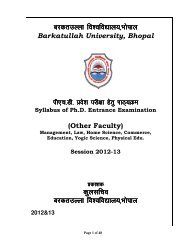
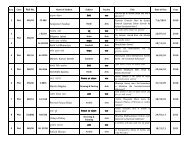
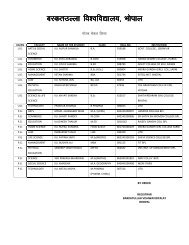
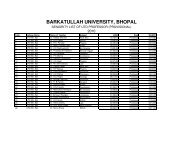

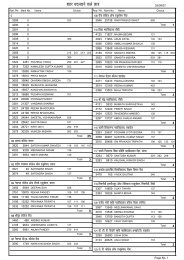
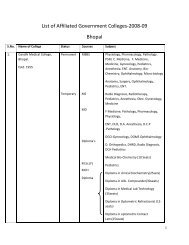
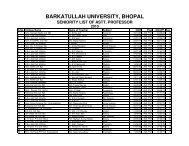
![cjdrmYyk fo'ofo|ky;] Hkksiky cjdrmYyk fo'ofo|ky;] Hkksiky - Barkatullah ...](https://img.yumpu.com/46923562/1/190x245/cjdrmyyk-foofo-ky-hkksiky-cjdrmyyk-foofo-ky-hkksiky-barkatullah-.jpg?quality=85)
